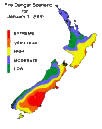New Zealand has been an isolated group of islands since the formation of the Tasman Sea cut it off from the supercontinent Gondwana, 80 million years ago. It is located approximately 1,930 kilometers (1,200 miles) east of Australia and 7,200 km ( 4,550 mi) south of Hawaii. It lies between 34 ° S and 47 ° S latitude, comparable to the latitude of Los Angeles to Seattle in North America. The distance from the top of the North Island to the bottom of the South Island is 1,930 km (1,200 mi) and no point is more than 120 km (70 mi) from the coastline.
Please select root levels for the menu
NZ Plants
New Zealand Facts
Climate
New Zealand lies within a band of westerly flowing winds that are moisture-laden from the surrounding expanses of sea. The main ranges of both North and South Islands provide a barrier to the prevailing winds resulting in high rainfalls on western slopes and low rainfalls and high sunshine to the east. The climate is cool temperate throughout most of the country, but extremely cold temperatures may occur at alpine areas and very warm temperatures at lower elevations in more easterly regions of both islands. Precipitation varies from 335 mm in Alexandria in Central Otago to 7094 mm in Fiordland.
Geology
New Zealand is located at the junction of the Pacific and Indo-Australian tectonic plates. In the North Island, the Pacific plate is being pulled under the Indo-Australian plate in the process known as subduction and volcanism is prevalent. In the South Island, portions of both plates overlap, but there is no subduction zone and the resulting uplifting has created 18 peaks over 3,000 meters with about 360 glaciers.
Plants
New Zealand plants are descended from plants present at the time of its isolation 80 million years ago and those plants which came over the sea in the intervening period. Long isolation has led to a high percentage of species found nowhere else. This endemism is high in the seed plants (85%) but less so in the ferns (41%). Native species which are not endemic are shared predominantly with Australia. The majority of plants are evergreen and perennial. Annual plants are uncommon. Curious features include the widespread occurrence of juvenile forms that are markedly different from those of the adult; shrubs with dense tangled branches and small leaves; mat and cushion alpine plants; and megaherbs of alpine areas and the subantarctic islands.
Native Animals
The only native mammals are two species of small, forest-dwelling bats. There are four species of earless, silent frogs with eggs that retain tadpoles. Reptiles include over 40 species of lizard (geckos and skinks), and the ancient Tuatara. Forest birds include the honey eaters such as the tui and bellbird and over 12 species of arboreal insectivores. Flightless birds are the kiwi, weka and a large, flightless, nocturnal parrot. There are also predators such as the falcon, owl and kingfisher and many species of shore birds. Many invertebrates are flightless and exceptionally large such as the weta, the giant land snails and some earthworms.
Introduced Animals
Many animals have been introduced and have had a negative effect on native fauna and flora. Mammals include the rat, mouse, rabbit, ferret, weasel, stoat, deer, chamois, thar, goat, pig, cattle, horses, hedgehogs, cat and dog. The Australian brushtail possum, a marsupial, is also widely distributed and very destructive.
Population and Land Use
There are over 4 million people of which 75% live on the North Island. Eighty five percent of New Zealanders live in urban areas and 14 % of New Zealanders are indigenous Maori. Approximately 70% of the land is devoted to farming, horticulture and tree plantations. The remainder is urban or within national parks. There are 14 national parks and numerous reserves that occupy almost a third of the country's land.







